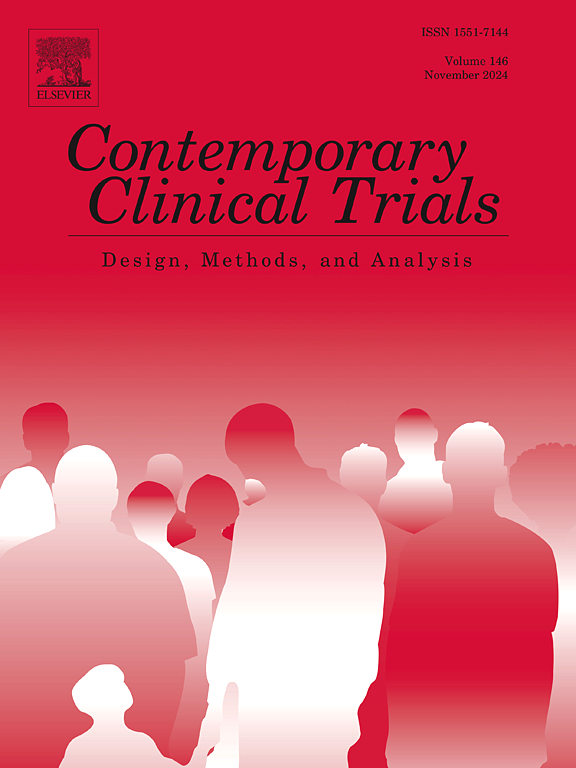Handling non-ignorable missing intimal hyperplasia data – Lessons from the VEST trial
IF 2
3区 医学
Q3 MEDICINE, RESEARCH & EXPERIMENTAL
引用次数: 0
Abstract
Non-ignorable missing data arise often in clinical trials. The VEST trial, a randomized, within-patient-controlled study, assessed the effect of an external scaffold for saphenous vein grafts on intimal hyperplasia (IH) one year after coronary artery bypass graft surgery. It was anticipated that approximately 13 % of grafts would be occluded and unsuitable for intravascular ultrasound, resulting in missing IH values at 1-year. Given graft occlusion is a negative outcome and higher IH is associated with occlusion, this missing data is non-ignorable. To address this, we developed a novel two-part method for the MNAR (missing not at random) scenario in the VEST trial. This method combines penalized multiple imputation with a modified Wilcoxon signed-rank test. We evaluated the approach's performance against alternatives in a series of simulation studies. The new method did not show type I error inflation. Under trial assumptions, it provided adequate power. However, if missing data exceeds 20 %, power decreases notably with the double penalization method due to underestimation of the treatment effect. When missing data is balanced between arms, penalized multiple imputation alone is more powerful and unbiased. Conversely, for unbalanced MNAR data, as might occur with a treatment effect on IH, the penalized multiple imputation with a modified Wilcoxon signed-rank test approach is more powerful. The VEST trial showed more occlusions than expected, balanced across arms, resulting in potential underestimation of the true treatment effect. However, given the potential for unbalanced missingness, this approach was suitable and could be applied in other settings with similar challenges.
处理不可忽视的缺失内膜增生数据-来自VEST试验的教训
临床试验中经常出现不可忽视的数据缺失。VEST试验是一项随机、患者对照研究,评估了冠状动脉搭桥术后一年内隐静脉移植物外部支架对内膜增生(IH)的影响。预计大约13%的移植物会被阻塞,不适合血管内超声,导致1年的IH值缺失。鉴于移植物闭塞是一个负面结果,较高的IH与闭塞有关,这一缺失的数据是不可忽视的。为了解决这个问题,我们为VEST试验中的MNAR(非随机缺失)场景开发了一种新的两部分方法。该方法将惩罚多重插值与改进的Wilcoxon符号秩检验相结合。我们在一系列模拟研究中评估了该方法与替代方案的性能。新方法没有显示I型误差膨胀。在试验假设下,它提供了足够的电力。然而,当缺失数据超过20%时,由于对处理效果的低估,双重惩罚法的功率显著降低。当缺失的数据在两方之间得到平衡时,单独的惩罚多重imputation更有力、更公正。相反,对于不平衡的MNAR数据,如可能发生在IH治疗效果中,使用改进的Wilcoxon符号秩检验方法的惩罚多重输入更有效。VEST试验显示闭塞比预期的要多,在两臂之间平衡,导致对真实治疗效果的潜在低估。然而,考虑到不平衡缺失的可能性,这种方法是合适的,可以应用于具有类似挑战的其他环境。
本文章由计算机程序翻译,如有差异,请以英文原文为准。
求助全文
约1分钟内获得全文
求助全文
来源期刊
CiteScore
3.70
自引率
4.50%
发文量
281
审稿时长
44 days
期刊介绍:
Contemporary Clinical Trials is an international peer reviewed journal that publishes manuscripts pertaining to all aspects of clinical trials, including, but not limited to, design, conduct, analysis, regulation and ethics. Manuscripts submitted should appeal to a readership drawn from disciplines including medicine, biostatistics, epidemiology, computer science, management science, behavioural science, pharmaceutical science, and bioethics. Full-length papers and short communications not exceeding 1,500 words, as well as systemic reviews of clinical trials and methodologies will be published. Perspectives/commentaries on current issues and the impact of clinical trials on the practice of medicine and health policy are also welcome.

 求助内容:
求助内容: 应助结果提醒方式:
应助结果提醒方式:


